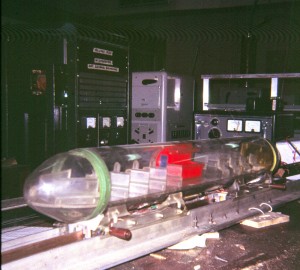In recent months, whilst the blog has been on hold, I gather there has been great interest in the late Professor Eric Laithwaite’s research work. To see all the videos available that feature him, you may wish to go to the Imperial College YouTube Archive Playlist.

Some while ago I came across footage of the experimental tracked hover train that was built at Erith in the UK. He had expanded his original designs of the Linear Motor, with support from a government grant of £5 million. The result was a prototype for the world’s first magnetically levitating train. The ‘Tracked Hovertrain’, as the prototype was called, was a high-speed, wheel-less vehicle which was propelled by the force of a magnetic field. Early trials of Laithwaite’s model looked promising with the prototype reaching speeds of up to 100mph, yet in 1973 the government cancelled the project, blaming high costs for little return.

I know very little about the project, but after the Government brought it to a halt there were bitter exchanges between Eric Laithwaite and Government Ministers. Around 1974 Eric Laithwaite asked me to make a recording (in audio) -in his own words- of what really happened; who said what and why. In front of me, that audio tape was put into an envelope, sealed and signed and was then to be held in his bank until his death. That tape DID surface again after his death, I personally unsealed it and transferred the contents into digital form! I did not keep a copy of this tape or digital transfer.

Imperial College does not hold any RTV31 footage or photos related to that project. However the footage I did come across is held by the ITN Source Library in the UK. It’s really only available to buy but people can see a preview of the footage, which is good enough to see what the vehicle looked liked and how it operated. The video is located on the ITN website and can be seen via the link below. I have also given the ITN information related to the clip at the bottom.
The two colour photos on this page were taken by me in December 1966 and are seen here for the first time. In was later in this month that Eric Laithwaite presented the first televised Royal Institution Christmas Lectures, so the Linear Motor being made and the model train too, could have been for that event.
I was about to make this new entry live when, by chance, I came across this video on Youtube. It seems that the RTV31 shell still exists, although it’s painted very differently to the original footage you’ll see from ITN. It’s housed at Railworld, Oundle Road, Peterborough, PE2 9NR. The Youtube video is in French but it has Youtube ANNOTATIONS added in English. So ensure the Annotation options in the player window is set to ON (it should be a RED square when the video runs).
See also: Engineering the Hovertrain
Colin Grimshaw November 2012
Hi Colin – Very interested in you article on RTV 31 … The sad thing is no one wanted to know – We had to struggle to raise funds to bring the hulk to Peterborough.If we had not ‘she’ would have been unceremoniously chopped up – The One Show did express an interest last year – But nothing since – We need an ambassador to promote and secure RTV 31 for the future – We also have a Birmingham Maglev …
We do have paperwork on the project and pictures…You are welcome to browse – We are all volunteers – Struggle to promote RTV 31’s amazing historical significance – Look at the Maglev in China …Laithwaite was an incredible man and I do have film/video footage of him opening the RTV display in 1995.
I loved his tv presentations.
About 1960, I remember a magnetically levitated train test track in a field just outside Glasgow. My cycling club passed by it between Bearsden and Milngavie very time we were on our way to the Trossachs. I assumed it was a university test bed but never found out any more. The track is now gone, but the field is still there. Most likely would have been parallel research at the same time as Eric’s – a fashionable topic at the time I remember.
OK, I was wrong in my earlier post. I now think it was the Bennie monorail track using electric motors, not magnetically levitated. I don’t remember the raised track as shown in the website picture,
http://www.rampantscotland.com/know/blknow22.htm
So it must have been removed just before my cycling days there, and I was relying on a conversation with someone else on my info.
I have just read this article and find it fascinating. I attended Kirkham Grammar School near Preston from 1959 to 1965. Eric Laithwaite was also a former pupil of KGS and he came to the school to give a lecture on Linear Induction Motors possibly about 1963. He had with him several working models of devices using linear induction. Some simply “floated” on electro magnetism. Others floated and were driven by electromagnetism. The most memorable demonstration was when he covered a number of table tennis balls with aluminium foil and dropped them into a plastic tube, then dropped wire coils around the tube which were powered by three phase current in phased order. Upon switching on the power the balls shot out in all directions! Since that day I have followed Eric Laithwaite’s career with interest. His Christmas Lectures showed his capacity to engage young people’s interest and explain often complex situations in simple terms. I believe that he should certainly be regarded as one of Britain’s if not the worlds most renowned scientists. It was one of my greatest memories to have actually met him. Eric Hornby
Thanks for this! I’ve been writing a bit about the 60’s efforts to levitate trains,run em through tubes (or both), bore tunnels with nuclear powered TBM’s (and so forth) in the context of the latest Hyperloop designs (some with linear motors).
The ITN interview you link to is bittersweet- especially seeing the follow on YouTube of the French fellow “discovering” this prototype.
In the US, this effort was repeated in the early 70s by the DOT and Rohr- (Air cushion and induction motor). That prototype too sat and sat for years- Finally being rescued by the Pueblo Rail museum.
Anyhow- Glad to have come upon your site.
Excellent post. I am no expert, but I have a hunch that they were on to something. Here we are 40 years later still struggling to build a high speed network using locomotives imported from Japan. I think this is an area of research that should be pursued. In the light of Hyperloop gaining traction, I think it makes sense to take a second look.
saludos amigos,sin duda el profesor eric,siempre estuvo adelantado a su tiempo con su amena forma de explicar las cosas mas complejas. un ser maravilloso tengamoslo siempre presente sus investigaciones y videos ya son de culto,para siempre.
Greetings friends, Professor Eric, without a doubt, was always ahead of his time with his entertaining way of explaining the most complex things. a wonderful being, let us always keep him in mind, the investigations and videos of him are already a cult, forever.
To think how far ahead this country could have been in transporting people from one end of this island to the other if not for so called leaders ( MPs) who cannot see past their money investments then and not the future. I watched professor laithwaite on tomorrow’s world and thought genius turn an electric motor inside out. I even entered into Ford’s ideas box for conveyer belts answer to advanced never mind what a lost by backward thinkers J Johnson